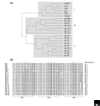Sp1- and Krüppel-like transcription factors
- PMID: 12620113
- PMCID: PMC151296
- DOI: 10.1186/gb-2003-4-2-206
Sp1- and Krüppel-like transcription factors
Abstract
Sp1-like proteins and Krüppel-like factors (KLFs) are highly related zinc-finger proteins that are important components of the eukaryotic cellular transcriptional machinery. By regulating the expression of a large number of genes that have GC-rich promoters, Sp1-like/KLF transcription regulators may take part in virtually all facets of cellular function, including cell proliferation, apoptosis, differentiation, and neoplastic transformation. Individual members of the Sp1-like/KLF family can function as activators or repressors depending on which promoter they bind and the coregulators with which they interact. A long-standing research aim has been to define the mechanisms by which Sp1-like factors and KLFs regulate gene expression and cellular function in a cell- and promoter-specific manner. Most members of this family have been identified in mammals, with at least 21 Sp1-like/KLF proteins encoded in the human genome, and members are also found in frogs, worms and flies. Sp1-like/KLF proteins have highly conserved carboxy-terminal zinc-finger domains that function in DNA binding. The amino terminus, containing the transcription activation domain, can vary significantly between family members.
Figures


References
-
- Dynan WS, Tjian R. The promoter-specific transcription factor Sp1 binds to upstream sequences in the SV40 early promoter. Cell. 1983;35:79–87. Identification of Sp1. - PubMed
-
- Kadonaga JT, Carner KR, Masiarz FR, Tjian R. Isolation of cDNA encoding transcription factor Sp1 and functional analysis of the DNA binding domain. Cell. 1987;51:1079–1090. Cloning of the cDNA that encodes Sp1. - PubMed
-
- Dang DT, Pevsner J, Yang VW. The biology of the mammalian Kruppel-like family of transcription factors. Int J Biochem Cell Biol. 2000;32:1103–1121. doi: 10.1016/S1357-2725(00)00059-5. This review provides a classification scheme of Sp1-like/KLF proteins and discusses their roles in regulating transcription, cell proliferation, differentiation and development. - DOI - PMC - PubMed
Publication types
MeSH terms
Substances
Grants and funding
LinkOut - more resources
Full Text Sources
Other Literature Sources
Miscellaneous

